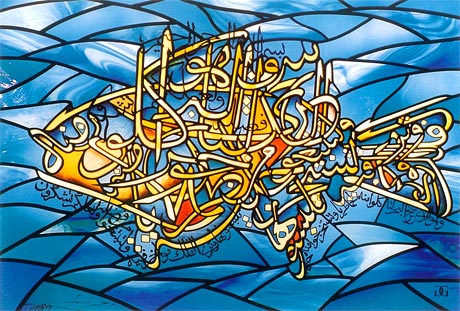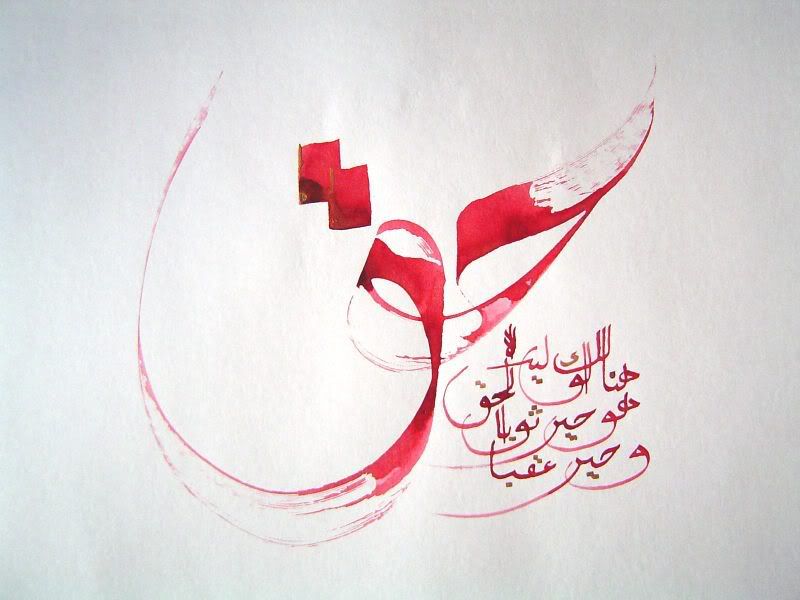|
|
sesiapa yg ada foto berkaitan islamic callirgaphy boleh ler share
lebih baik jika pelukisnnya sendiri menampilkannya
 |
Rate
-
1
View Rating Log
-
|
|
|
|
|
|
|
|
|
|
|
Khalid Al Saai. Syarian 2003
Water Colour, natural ink and tempera on paper
 |
|
|
|
|
|
|
|
|
|
|
|
Dr Nihad Dukhan Blessed among the crafts, Arabic calligraphy possesses an emotive appeal and a visual impact that captivates and invites the viewer to meditation. It is generally rooted in the sacred and is a celebration of the divine. Dr. Dukhan's fascination with the Arabic language, written and spoken, started when he was in grade school. He has been training himself in all the classical styles of Arabic calligraphy by imitating the works of many master calligraphers. In 1998, he became a student of the noted Istanbul master calligrapher Hasan Celibi in Thuluth and Naskh style and recently, of master calligrapher Mohamed Zakariya in T抋liq style. Although inspired by, and occasionally resembling some of the classical styles of Arabic calligraphy, the modern look of his designs is achieved through innovation guided by artistic sensibility and a certain quality of pursuing the form. His designs are highly stylized, but remain legible, and offer a fresh rendering of the Arabic letters.
 |
|
|
|
|
|
|
|
|
|
|
|
|
Khaled Al Saai was born in Syria in 1970. He grew up in a household surrounded by painting, music and calligraphy. By the age of eighteen he had already established a reputation as a calligrapher. He graduated from the University of Damascus in 1998 with his MA in Fine Art, and went on to become an internationally recognized master of Arabic calligraphy. He has participated in many international art competitions and held solo exhibitions throughout Europe and several Middle Eastern countries. In 1997, at the first International festival of Calligraphy, Teheran, Iran, he was nominated one of the best ten international calligraphers. He then went on to obtain a certificate of distinction at the festival of music, poetry and calligraphy, Oberani, France. In 2001, he obtained the Diwani Jali style prize at the Fifth International competition of Arabic calligraphy, Istanbul, Turkey. In 2002, he went on to teach 揑ntroduction to Arabic Calligraphy |
|
|
|
|
|
|
|
|
|
|
|
Samir Malik ( Fahdi)
 |
|
|
|
|
|
|
|
|
|
|
|

I will leave you with this painting by Egyptian artist Ahmed Moustafa |
|
|
|
|
|
|
|
|
|
|
|
A multi-coloured text transcribed on a black background with gold flecks. This complicated text illustrates sayings in Arabic of the Amir of Yatib, Batha and Nahhaf, which relate to the words of the Prophet Mohammad. It should be read following the sequence of the colours.
Arabic; dated 1707/8; transcribed in Cairo.
 |
|
|
|
|
|
|
|
|
|
|
|
The calligrapher Hassan Massoudy was born in Baghdad in 1944, but has lived and worked in Paris since the late 1960s.
 What can be admired in Hassan Massoudy is the masterful use he makes of colours in his compositions. He has opalescent washes, flows of emerald, monochromes of beiges enriched with deep wood tones and sandalwood fragrances. This is a new era, which is then open to calligraphy. Indeed, lovers of exoticism and antique may be disappointed. Hassan Massoudy is not the living fossil of the old Arabic calligraphy. He is an artist of our time. His art belongs to that very end of the twentieth century, despite the ancestral roots that he immerses in the tradition of the Orient. - Michel Tournier.  The colours are most certainly vibrant, even within the restrictive confines of reproductions such as these. I'd love to see some of these works in their original state. The colours are most certainly vibrant, even within the restrictive confines of reproductions such as these. I'd love to see some of these works in their original state.
 The sense of community is essential for Massoudy, and that community is most emphatically not limited to Islam. Much of his work focuses on peace and tolerance as a prerequisite of all that has value, and this quite naturally leads him into work with Amnesty International, UNICEF, and other related organizations. If peace forms one of Massoudy's major themes, it reaches back into one of the basic social currencies of his tradition, the proverb - Karl Young.  Whether derived from proverb or quotation, the texts and titles of Massoudy's works seem as though chosen with the utmost precision and tact. Whether derived from proverb or quotation, the texts and titles of Massoudy's works seem as though chosen with the utmost precision and tact.
 Hassan Massoudy's calligraphies enact a rhythm, a musical structure which echoes back to the very remotest times. Powerful emotions are evoked by the movement of his lines, their weight, their lightness, their transparency; the balance between black and white, the fullness and the vacuum, the concreteness and the abstractness... The artist has retained from his training the noble spirit of an artisan able to make his own tools and to fix his own inks and pigments...  Numerous books about Massoudy's art, or otherwise illustrated by him, have been published in France. Numerous books about Massoudy's art, or otherwise illustrated by him, have been published in France.
 All but the last of these images were taken from this site. All are All but the last of these images were taken from this site. All are |
|
|
|
|
|
|
|
|
|
|
|
 unknown unknown |
|
|
|
|
|
|
|
|
|
|
|
cantiknya.. mashaallah.. :eek:  hmy3: hmy3: |
|
|
|
|
|
|
|
|
|
|
|
|
very tastefully done.. mana nak dapat caligraph yg lawa-lawa cam ni kat m'sia? printed pun takpe |
|
|
|
|
|
|
|
|
|
| |
Category: Belia & Informasi
|